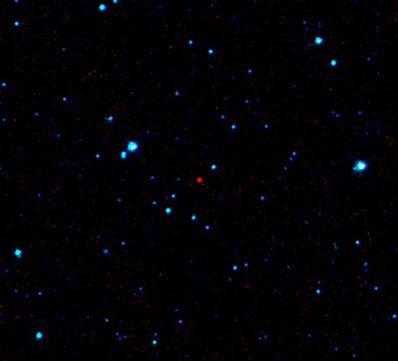
WISE spies its first
Near Earth Asteroid
DR EMILY BALDWIN
ASTRONOMY NOW
Posted: 26 January 2010


NASA’s Wide-field Infrared Survey Explorer, WISE, has spotted its first never-before-seen Near Earth Asteroid (NEA), the first of hundreds it is expected to uncover during its mission to map the whole sky in infrared light.
The one kilometre wide object, 2010 AB78, was discovered on 12 January and poses no threat to the Earth. It is currently 158 million kilometres from Earth and circles the Sun in an elliptical orbit tilted to the plane of our Solar System, but it will not approach the Earth for many centuries to come.
 The red dot at the centre of this image is the first NEA discovered by WISE. The image shows three infrared wavelengths, with red representing the longest wavelength of 12 microns, and green and blue showing 4.6- and 3.4-micron light, respectively. The asteroid appears redder than the rest of the background stars because it is cooler and emits most of its light at longer infrared wavelengths. In visible light, this space rock is very faint and difficult to see. Image: NASA/JPL-Caltech/UCLA. The red dot at the centre of this image is the first NEA discovered by WISE. The image shows three infrared wavelengths, with red representing the longest wavelength of 12 microns, and green and blue showing 4.6- and 3.4-micron light, respectively. The asteroid appears redder than the rest of the background stars because it is cooler and emits most of its light at longer infrared wavelengths. In visible light, this space rock is very faint and difficult to see. Image: NASA/JPL-Caltech/UCLA.
WISE picked out the moving asteroid against a background of stationary stars, observing the object several times over a period of one and a half days. Follow-up observations using the University of Hawaii’s 2.2-metre visible-light telescope confirmed the discovery.
“We are thrilled to have found our first new near-Earth object,” says Amy Mainzer of NASA’s Jet Propulsion Laboratory, principal investigator of the program called NEOWISE, which mines the WISE data for new objects. “Many programs are searching for near-Earth objects using visible light, but some asteroids are dark, like pavement, and don’t reflect a lot of sunlight. But like a parking lot, the dark objects heat up and emit infrared light that WISE can see.”
WISE will observe the infrared light of tens to hundreds of thousands of objects to characterise this population of NEA. In visible light estimates of an asteroid’s size can be deceiving since a small, light-coloured asteroid can look the same as a big, dark one. In infrared, however, a large, dark rock will emit more thermal heat – or infrared glow – thus revealing its true size. Collating information on the size distribution of asteroids will give researchers a better estimate of how often Earth can expect to be threatened by potentially devastating impacts.
“This is just the beginning,” says Ned Wright, the mission’s principal investigator from UCLA. “We’ve got a fire hose of data pouring down from space.”
Observations from WISE will be analysed by the clearinghouse for Solar System bodies, the Minor Planet Center, for comparison against the known catalogue of Solar System objects. If a new object is revealed, follow-up observations will then determine its orbit. Mission scientists predict that WISE will turn up previously unseen rocky bodies located in both the Asteroid Belt and those on elliptical slingshots around the Sun like 2010 AB78.
“It is great to receive the first of many anticipated near-Earth object discoveries by the WISE system,” says Don Yeomans, manager of NASA’s Near-Earth Object Program Office at JPL. “Analysis of the WISE data will go a long way toward understanding the true nature of this population.”
WISE began its official survey on 14 January. As well as asteroids, it will also study distant galaxies and stars to create an atlas of new objects that covers the entire celestial sphere.
|



